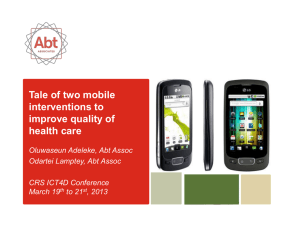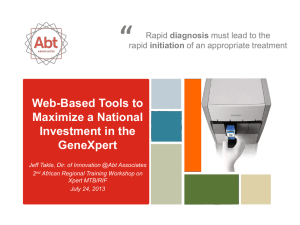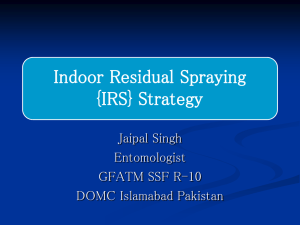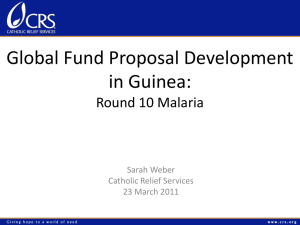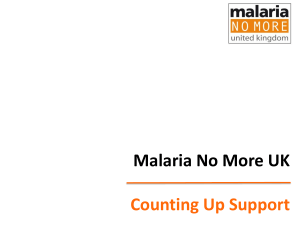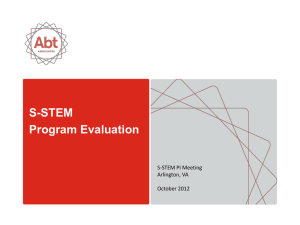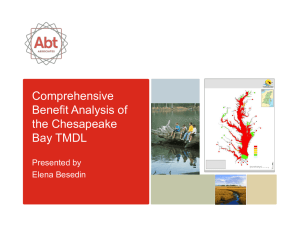Combining Entomological, Epidemiological, and Spacial
advertisement
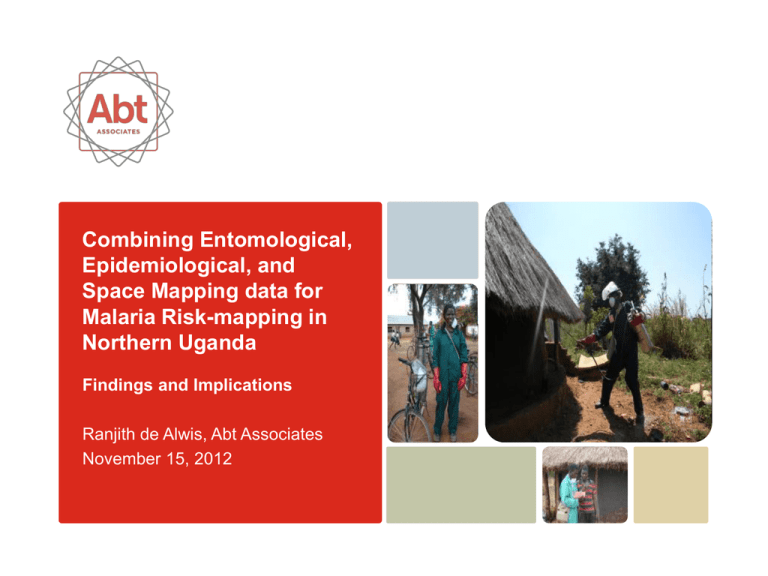
Combining Entomological, Epidemiological, and Space Mapping data for Malaria Risk-mapping in Northern Uganda Findings and Implications Ranjith de Alwis, Abt Associates November 15, 2012 Contents Malaria and malaria control in Uganda Indoor residual spraying (IRS) in Uganda Impact of IRS on malaria prevalence Entomological monitoring activities and findings Risk mapping Lessons learned Recommendations Abt Associates | pg 2 Malaria and Malaria Control Malaria transmission highly endemic and perennial 90% of population at risk 99% Plasmodium falciparum Major vectors Anopheles gambiae Anopheles funestus Interventions IRS ITNs/LLINs IPT Improved diagnosis/case management Abt Associates | pg 3 Indoor Residual Spraying (IRS) IRS—most effective malaria vector control method Currently, the primary factor for deciding where to use IRS is malaria incidence, which results in expensive blanket coverage Stratification based on risk—more effective strategy but requires reliable and representative data over time Abt Associates | pg 4 Indoor Residual Spraying (IRS) Data needed for planning IRS Vector bionomics (species and behaviour) Vector susceptibility to insecticides Suitability of structures and population compliance Malaria prevalence patterns to determine time to spray On-going monitoring needs for decision making Vector bionomics Vector susceptibility Residual efficacy of insecticide Data needed for decisions on phase-out or scale-up of IRS Malaria epidemiological data over the time Meteorological information Feasibility of carrying out of other interventions Abt Associates | pg 5 Indoor Residual spraying (IRS) Started in 2006 in South Western districts Moved to Northern districts in 2007 7-8 rounds have completed Started with Lambda-Cyhalothrin Then moved to Alpha-Cypermethrin DDT was used in 2 districts for one round Since 2010 Bendiocarb Target Population – 2.8 million Approx. 900,000 structures Abt Associates | pg 6 Impact of IRS on Malaria Prevalence Marked reduction in malaria cases, especially after Bendiocarb Abt Associates | pg 7 Impact of IRS on Malaria Prevalence Location based data not available in health institutions Difficulties in combining epidemiological data with other information Abt Associates | pg 8 Entomological Monitoring Activities Pre- and post-spraying PSCs Post-spraying wall bioassays Monthly wall bioassays National Susceptibility Study (2011) Vector bionomics **** Abt Associates | pg 9 Pyrethroid Spray Collections (2009-12) Abt Associates | pg 10 Monthly Wall Bioassays (200912) Abt Associates | pg 11 National Susceptibility Study Abt Associates | pg 12 Risk Mapping 2005 risk map based on malaria endemicity. 2012 risk map detailed at district level to facilitate development of national vector control policy. Planned to used a spatial model based on district-level information: Malaria prevalence data Entomological data Intervention data Meteorological data Demographic, physical and geographical data Data challenges Malaria data is not representative or reliable No recent entomological data Low, predictive power of the risk map model – Need to improve. Abt Associates | pg 13 Malaria Risk Maps Abt Associates | pg 14 Lessons Learned IRS effectiveness Combining all these data help us to – Use correct insecticide – Manage resistance – Understand residual efficacy Indoor resting behavior Reduction of malaria prevalence / When to phase out IRS Strengthen other control methods. Importance of location based data at lower administration levels Risk mapping in project area Will allow scale up of malaria control activities nationally while phasing out/reducing IRS in on-going areas Abt Associates | pg 15 Recommendations To scale up vector control nationally while reducing IRS in on-going areas, we will need: Location based data Confirmed malaria cases Establishment of indicators institutions Spatial analysis of population distribution Spraying time and frequency Vector bionomics Resistance status Abt Associates | pg 16


